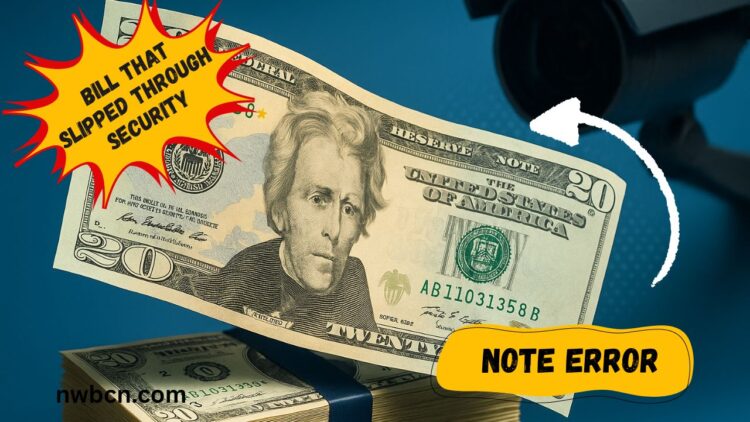Imagine discovering a $20 note in your pocket that looks ordinary—until you notice something is off. Such a note should never have left the Bureau of Engraving and Printing (BEP), yet somehow it did.
These are known as True Errors—banknotes with misprints tied to genuine production mistakes rather than dealer alteration or wear.
One famous case involves a serial number mismatch that went all the way to auction, amassing unprecedented value.
What Is a True Error Note?
True errors occur during the printing process and can manifest in several forms:
- Mismatched serial numbers: front and back numbers don’t match.
- Misplaced seals or headers: shifts due to plate alignment.
- Ink smears, stains, or bleed-through.
- Retained obstructions: foreign objects (stickers, tape) that become part of printing.
These errors are rare, often caught during inspection. When one slips through into circulation, it becomes an instant numismatic sensation.
The Famous Serial Mismatch Case
In January 2020, a collector at the FUN Show in Florida found a 2013 Boston $20 note with mismatched serial numbers. PMG certified it as a real production error. Examples include:
- Priceless at the show: a Richmond 2013 note (PMG 66 EPQ) with mismatched numbers sold for $1,140.
- Smaller cases: an Orlando note graded PMG 30 VF sold quietly but was valued in the low hundreds, yet still significantly above face value.
These examples highlight how BEP’s quality control works—but isn’t flawless.
Notable $20 Error Attributes & Auction Prices
| Error Type | Note Series | Condition & Grading | Known Auction Value |
|---|---|---|---|
| Mismatched serial numbers | 2013 Boston | PMG 66 EPQ | $1,140 |
| Same error | 2013 Orlando | PMG 30 VF | Several hundred dollars |
| Misaligned print | 1974 offset | Unspecified | $288–$350 (eBay) |
| Obstructive sticker | 1996 Del Monte | PMG/Heritage graded | Up to $57,500 |
How Production Errors Occur
- Serial number mismatch: Printing uses two numbering wheels for front and back. If one wheel sticks temporarily, two different numbers are printed.
- Alignment issues: Multi-step printing (offset, intaglio, overprint) may misalign or (rarely) miss certain passes, leading to missing seals or shifted images.
- Retained obstructions: Items left on the sheet—like a Del Monte sticker—block part of the process and become part of the note.
Why Such an Error Increases Value
- Scarcity: True error notes are rare—often just a few made it past QC.
- Novelty: These notes are visually intriguing and easy to verify.
- Collector interest: Certified error notes are market-validated and highly tradeable.
- Provenance: Auction records lend legitimacy and pricing benchmarks.
Some Common $20 Error Types & Values
| Error Type | Market Value | Rarity & Appeal |
|---|---|---|
| Serial mismatch | $500–$1,200+ (graded) | High—numbers rarely aligned |
| Misalignment/offset print | $200–$400+ (eBay range) | Medium—occurs occasionally |
| Obstructed print (sticker) | $10,000–$60,000+ | Very rare—object remains on note |
| Ink smear/blotch errors | $50–$300+ | Common—less valuable but collectible |
How to Spot a Mismatched Serial Error
- Examine the serial numbers on front and back—they should match exactly.
- Check seal and Federal Reserve identifiers—they should align.
- Look for image misalignments, ink blotches, or smudges.
- Document the note with clear photos.
- Submit to a grading service (PMG or PCGS Currency) for verification and grading.
Why Some Errors Shouldn’t Exist—but Do
- Quality control is robust, yet occasional human or mechanical errors occur.
- Complexity of processes (multi-step printing, high volume) increases error likelihood.
- These anomalies reinforce faith in the system—if a few slip through, it shows checks are working yet not infallible.
BEP Error Probability & Control Points
| Production Stage | Errors Detected | Examples |
|---|---|---|
| Sheet printing | Offset plate misalignment | Misprints, blurs |
| Overprint (serials) | Sticker obstruction/mix-up | Del Monte error |
| Numbering wheels | Malfunctioning wheels | Serial mismatch |
| Machine feed/stacker | Fold-over or cut errors | Misaligned borders |
| Final QC inspection | Key step—most errors deleted | Occasionally detects nothing |
What to Do If You Have A Suspect Note
- Don’t spend or tear it—preserve as-is.
- Photograph it from multiple angles, capturing serials and seal.
- Avoid folding or handling excessively.
- Submit to PMG Currency or PCGS Currency for:
- Certification
- Error designation
- Provenance listing
- Once certified and graded, such a note becomes marketable and significantly valuable.
A $20 bill that shouldn’t exist—yet did—reminds us how even the most sophisticated printing systems can falter. These collectible gems, especially those bearing truly matched errors like serial mismatches, are rare and celebrated among numismatists. When one surfaces in circulation, it becomes a remarkable artifact of printing history—and a collector’s treasure.
FAQs
Q1: Are all $20 error bills valuable?
No. Value depends on rarity and type: obvious, uncommon errors (like sticker obstructions or serial mismatches) are prized, while minor misalignments fetch modest premiums.
Q2: How can I authenticate a suspected error note?
Submit it to a recognized grading service like PMG or PCGS Currency. Certified error notes are documented and give collectors confidence.
Q3: Can I legally spend an error bill?
Yes—it’s still legal tender at face value. But doing so would destroy its collectible worth, potentially worth hundreds or thousands more.
